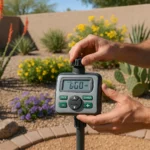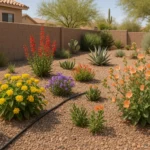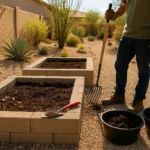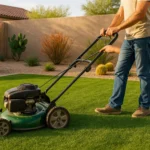As Chandler’s mild winter gives way to spring warmth, your garden is ready to burst into vibrant life. But before those desert blooms can shine, your irrigation system needs a proper tune-up. The key to a flourishing spring garden in our Arizona climate isn’t just what you plant—it’s how efficiently you water it. Setting up your irrigation timers correctly now can mean the difference between a thriving landscape and wasted water when those triple-digit temperatures arrive.
Why Spring Irrigation Adjustments Matter in Chandler
Spring in Chandler brings unique challenges to garden irrigation. Our transition from mild winters to increasingly warm days happens quickly, often catching gardeners off guard. Plants that needed minimal water in February suddenly require more frequent hydration as March and April temperatures climb. Without proper timer adjustments, your landscape can suffer stress during this critical growth period.
The stakes are particularly high in our desert environment. Chandler receives less than 9 inches of rainfall annually, making proper irrigation essential for plant survival. Spring is when most desert-adapted plants enter their primary growth phase, setting the foundation for their resilience during summer heat. Proper watering now helps develop deeper root systems that will sustain plants when temperatures soar above 100°F.
Additionally, water conservation remains a priority in our community. The Salt River Project and other water authorities often implement seasonal guidelines that homeowners should follow. By optimizing your irrigation system in spring, you’re not just nurturing your garden—you’re being a responsible steward of our limited water resources.
Inspecting Your Irrigation System After Winter
Before reprogramming your timers, a thorough system inspection is essential. Chandler’s mild winters rarely cause freezing damage to irrigation components, but other issues can develop during the dormant season. Start by turning on each zone manually from your controller and walking the entire area. Look for obvious problems like broken sprinkler heads, clogged drip emitters, or geysers from broken pipes. These issues waste water and create uneven distribution that can harm plants.
Pay special attention to drip irrigation components. These small emitters can become clogged with mineral deposits common in our hard Chandler water. Clear obstructed emitters by removing and soaking them in vinegar, or simply replace them—they’re inexpensive and crucial for efficient watering. Check that emitters are properly positioned near plant root zones, as winter winds may have moved lines away from plants.
Don’t forget to inspect valve boxes for signs of leaks or damage. Our Chandler soil, particularly in areas with caliche, can shift and put pressure on irrigation lines. Remove any accumulated debris from valve boxes and ensure electrical connections are secure and dry. This preventative maintenance can save significant headaches and expensive repairs later in the season when your plants are most dependent on reliable irrigation.
Understanding Your Controller: Basic Timer Functions

Modern irrigation controllers range from simple mechanical timers to sophisticated smart systems, but they all share common functions you’ll need to adjust for spring. The most basic setting is the start time—when your irrigation cycle begins. For spring in Chandler, early morning hours between 4:00 AM and 6:00 AM are ideal. This timing allows water to penetrate soil before the day heats up, reducing evaporation while giving plants moisture to face the warming day.
The run time (or duration) determines how long each zone operates. Different landscape areas have different needs—lawns typically require longer run times than desert-adapted shrubs. For spring, a general guideline for Chandler gardens is 10-15 minutes for spray zones watering lawns, 30-45 minutes for drip lines serving trees and larger shrubs, and 20-30 minutes for flower beds and smaller plants. These times should be adjusted based on your specific soil type and plant requirements.
The frequency setting—how many days between watering cycles—is perhaps the most important spring adjustment. As temperatures warm, you’ll likely need to increase frequency. In early spring (March), most established Chandler landscapes can thrive with irrigation every 5-7 days. By late spring (May), this typically increases to every 3-4 days for many plants. New plantings and containers will need more frequent watering throughout the season. Remember that different zones may require different frequencies based on sun exposure, plant types, and soil conditions.
Seasonal Programming for Chandler’s Spring Climate
Chandler’s spring unfolds in distinct phases, each requiring specific irrigation adjustments. In early spring (March), daytime temperatures typically range from 75-85°F, while nights remain cool. During this period, program your controller for less frequent but deeper watering—perhaps once every 5-7 days for established plants. This encourages roots to grow deeper in search of moisture, building drought resilience for summer.
As we move into mid-spring (April), both temperatures and evaporation rates increase. This is when many plants accelerate growth, requiring more consistent moisture. Adjust your controller to water every 4-5 days, maintaining similar run times but increasing frequency. For lawns, this might mean watering every third day rather than weekly. Monitoring soil moisture by digging a few inches down can help fine-tune these settings—soil should be moist but not saturated.
Late spring (May) in Chandler often brings our first taste of summer heat, with temperatures regularly exceeding 90°F and occasionally reaching triple digits. At this stage, most landscape zones will need irrigation every 2-3 days. Plants with southern or western exposure may require even more frequent watering. This is also when you should consider implementing a “pulse” watering strategy for slopes or clay soils—programming multiple shorter cycles on the same day rather than one long run to prevent runoff and improve absorption.
Smart Controllers and Weather-Based Adjustments
If you’re still using a basic timer, spring might be the perfect time to upgrade to a smart irrigation controller. These systems can significantly improve water efficiency in Chandler’s variable spring conditions. Weather-based controllers use local climate data to automatically adjust watering schedules. Some connect to weather stations or online services to track rainfall, temperature, and evapotranspiration rates, making daily adjustments that would be impractical to program manually.
Smart controllers offer particular advantages during Chandler’s spring monsoon season, which can bring sudden, intense rainfall. These systems can automatically skip scheduled irrigation cycles when natural precipitation provides sufficient moisture. Many models also include soil moisture sensors that can be placed in different landscape zones, providing real-time data about actual water needs rather than relying on predetermined schedules.
The investment in a smart controller typically pays for itself within 1-2 years through water savings. Many Chandler residents report 30-50% reductions in water use after installation. Some local water utilities even offer rebates for WaterSense-labeled smart controllers, making the upgrade more affordable. Popular brands that perform well in our desert climate include Rachio, Hunter Hydrawise, and Rainbird ESP-ME3, all of which offer smartphone control and customization for Chandler’s unique growing conditions.
Drip Irrigation Timing for Desert Plants
Drip irrigation is the preferred method for most Chandler landscapes, delivering water directly to plant root zones with minimal waste. However, timing drip systems requires a different approach than traditional sprinklers. Because drip emitters deliver water slowly—typically 0.5 to 2 gallons per hour—run times need to be significantly longer than spray irrigation. For spring, most established desert plants benefit from drip cycles of 30-45 minutes, allowing water to penetrate deeply into the soil profile.
Different plants in your Chandler landscape have varying water requirements, even in spring. Native desert plants like creosote and brittlebush need minimal supplemental irrigation once established—perhaps just once every 7-10 days even as temperatures climb. Desert-adapted non-natives like lantana and bougainvillea require more frequent watering as they begin active growth—every 3-5 days by late spring. Citrus trees and other fruit-bearing plants need consistent moisture during spring flowering and fruit set, typically every 7-10 days with longer run times (1-2 hours) to reach their deeper root systems.
Consider creating separate irrigation zones for plants with similar water needs, allowing you to program your controller more efficiently. If your system doesn’t allow for multiple zones, position plants with similar requirements together in your landscape. For newly planted specimens, supplement your regular irrigation schedule with hand-watering for the first few weeks until roots establish. Remember that proper spring irrigation for desert plants means watering deeply but infrequently, encouraging drought-tolerant characteristics even as you support new growth.
Lawn Irrigation Schedules for Spring Green-Up
If your Chandler property includes a lawn area, spring requires special attention to irrigation timing. Our common Bermuda grass lawns typically begin emerging from winter dormancy in late March to early April as soil temperatures warm. During this green-up period, proper irrigation supports healthy root development and dense turf that can better withstand summer stress. For established lawns, begin with watering 2-3 times per week in early spring, gradually increasing to 3-4 times weekly by May.
Watering depth matters more than frequency for developing healthy turf. Program your controller to run long enough to moisten soil 6-8 inches deep—typically 15-20 minutes per cycle for spray heads with good pressure. To determine if you’re watering deeply enough, push a long screwdriver into the lawn about 30 minutes after irrigation; it should penetrate easily to the desired depth. If you encounter resistance, increase your run time. Many Chandler lawns benefit from cycle-and-soak programming—running sprinklers for 5-7 minutes, pausing for 30 minutes, then repeating twice more to prevent runoff and improve penetration.
Spring is also when many Chandler homeowners overseed winter ryegrass or prepare to transition back to summer Bermuda. These situations require specialized irrigation schedules. For ryegrass transition, gradually reduce watering frequency in April to stress the winter grass while encouraging Bermuda growth. If you’re establishing new turf areas, you’ll need frequent, light irrigation—perhaps 3-4 times daily for 5 minutes each—until seed germinates, then transition to deeper, less frequent watering as roots establish. Always water in the early morning to minimize disease pressure that can affect lawns during humid spring conditions.
Adjusting for Chandler’s Micro-Climates
Despite Chandler’s relatively uniform climate, significant micro-climate variations exist within individual properties. South and west-facing areas receive more intense afternoon sun and heat up faster in spring, often requiring more frequent irrigation than north-facing zones. Areas near walls, driveways, or reflective surfaces experience higher temperatures and evaporation rates. Program these zones separately if possible, increasing frequency by 25-30% compared to cooler areas of your landscape.
Wind exposure also creates irrigation challenges in spring, when Chandler often experiences breezy afternoons. Areas regularly exposed to wind suffer from increased evaporation and may need longer run times or more frequent cycles. Consider installing pressure-regulated sprinkler heads in these zones to maintain consistent water delivery regardless of wind conditions. For drip irrigation in windy areas, use emitters with lower flow rates (0.5 GPH rather than 2 GPH) and program longer run times to ensure water penetrates deeply rather than evaporating quickly.
Soil type variations across your property also necessitate different irrigation approaches. Chandler properties often have multiple soil profiles—sandy areas drain quickly and require more frequent watering with shorter run times, while clay soils hold moisture longer but need slower application rates to prevent runoff. Identify these variations and adjust zone programming accordingly. For problem areas with poor drainage or excessive runoff, consider soil amendments or creating separate irrigation zones with specialized programming to address specific challenges.
Monitoring and Fine-Tuning Your Spring Irrigation
Even the most carefully programmed irrigation schedule requires ongoing monitoring and adjustment throughout spring. Chandler’s temperatures can fluctuate dramatically, with occasional late-season cold snaps or early heat waves that demand quick irrigation adaptations. Check soil moisture regularly by digging a small hole 4-6 inches deep in different landscape zones. Ideally, soil should be moist but not soggy at this depth. If it’s dry, increase run time or frequency; if it’s consistently wet, reduce watering to prevent root rot and fungal issues.
Watch for plant stress signals that indicate irrigation problems. Wilting during afternoon heat might suggest insufficient water, while yellowing lower leaves could indicate overwatering. New spring growth that appears stunted or discolored often points to irrigation issues. Remember that some afternoon wilting is normal for certain plants in our climate and doesn’t necessarily indicate drought stress if plants recover overnight.
Create a spring irrigation calendar to track adjustments and plant responses. Note weather events, maintenance activities, and changes to your program. This record becomes invaluable for future seasons, allowing you to anticipate needs rather than react to problems. For those embracing technology, several smartphone apps designed for desert gardeners can help track irrigation schedules and plant health, providing reminders for seasonal adjustments specific to Chandler’s climate patterns.
Water Conservation Strategies for Spring Irrigation
Spring is an ideal time to implement water-saving practices in your Chandler landscape while still supporting healthy plant growth. Consider applying a fresh layer of mulch around plants—organic materials like compost or wood chips for ornamentals, and inorganic options like decomposed granite for desert natives. A 2-3 inch layer significantly reduces evaporation, moderates soil temperature, and can reduce irrigation needs by up to 30% during spring months.
Evaluate and improve your system’s efficiency by installing pressure regulators if water pressure exceeds manufacturer recommendations for your irrigation components. High pressure not only wastes water through misting and overspray but can damage system components. Similarly, check that spray heads have proper arc adjustments to avoid watering sidewalks and driveways. For drip systems, verify that emitter output matches plant needs—newly installed plants might require 2 GPH emitters, while established desert shrubs might thrive with 0.5 GPH emitters.
Consider harvesting springtime rainfall to supplement irrigation. Even Chandler’s limited precipitation can be captured from roof runoff and directed to landscape areas through simple grading or more elaborate rain garden designs. Strategic placement of rocks and berms can slow water movement across your property, allowing more time for absorption. These passive water harvesting techniques are particularly effective during spring’s occasional intense storms, turning potential runoff into a resource that reduces irrigation demands during our driest season.





